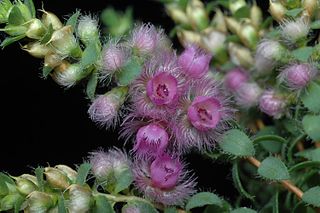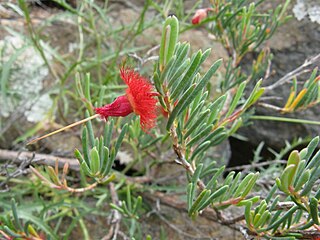Verticordia attenuata is a flowering plant in the myrtle family, Myrtaceae and is endemic to the south-west of Western Australia. It is a shrub with a single main stem, small leaves and pink to purple flowers which fade to white as they age. It usually grows in sand in areas that are wet in winter, often amongst grasses and is found in coastal areas near Bunbury.

Verticordia blepharophylla is a flowering plant in the myrtle family, Myrtaceae and is endemic to the south-west of Western Australia. It is an erect, open shrub with a single main stem, leaves with hairy margins and pale to deep mauve-pink flowers and which occurs in an area between Perth and Geraldton.
Verticordia capillaris is a flowering plant in the myrtle family, Myrtaceae and is endemic to the south-west of Western Australia. It is a shrub with a single stem at the base, small leaves and creamy white or occasionally pink flowers in dense corymb-like groups. It is common in small areas near Geraldton.

Verticordia halophila, commonly known as salt-loving featherflower, or salt-loving verticordia, is a flowering plant in the myrtle family, Myrtaceae and is endemic to the south-west of Western Australia. It is an erect, bushy shrub with small, crowded, thick leaves and spikes of red and pink flowers in spring.
Verticordia harveyi, commonly known as autumn featherflower, is a flowering plant in the myrtle family, Myrtaceae and is endemic to the south-west of Western Australia. It is a slender, spindly shrub with relatively long leaves and small white, pink or magenta-coloured flowers in late summer and autumn.

Verticordia helichrysantha, commonly known as coast featherflower or Barrens featherflower, is a flowering plant in the myrtle family, Myrtaceae and is endemic to the south-west of Western Australia. It is a small, woody, open-branched shrub with crowded, linear leaves and small yellow flowers from May to September.

Verticordia venusta is a flowering plant in the myrtle family, Myrtaceae and is endemic to the south-west of Western Australia. It is an openly branched shrub with small, egg-shaped leaves and spikes of pink to maroon-coloured flowers in spring and early summer.

Verticordia fimbrilepis subsp. fimbrilepis is a flowering plant in the myrtle family, Myrtaceae and is endemic to the south-west of Western Australia. It is a small bushy shrub with one openly branched main stem at its base, small, pointed leaves and rounded groups of pink flowers near the ends of the branches.
Verticordia gracilis is a flowering plant in the myrtle family, Myrtaceae and is endemic to the south-west of Western Australia. It is a low shrub with small leaves and rounded groups of fluffy pale to deep pink flowers in late spring or early summer, following rain.

Verticordia humilis, commonly known as small featherflower, is a flowering plant in the myrtle family, Myrtaceae and is endemic to the south-west of Western Australia. It is a small shrub with leafy branches and scattered, mostly red flowers hanging loosely near the ends of the branches.

Verticordia inclusa is a flowering plant in the myrtle family, Myrtaceae and is endemic to the south-west of Western Australia. It is a small shrub with small, thick leaves and groups of scented, mostly white to pale pink flowers with a red centre on the ends of the branches in spring.
Verticordia interioris is a flowering plant in the myrtle family, Myrtaceae and is endemic to the south-west of Western Australia. It is an openly branched shrub with small, linear leaves and rounded groups of pale to dark pink flowers in early spring.
Verticordia jamiesonii is a flowering plant in the myrtle family, Myrtaceae and is endemic to the south-west of Western Australia. It is small shrub with short leaves crowded on young branchlets and white to pale pink flowers in small groups on the ends of branches in early spring.
Verticordia minutiflora is a flowering plant in the myrtle family, Myrtaceae and is endemic to the south-west of Western Australia. It is a bushy shrub with small, crowded, cylindrical leaves and groups of white to pale pink flowers in summer and autumn. As suggested by its botanical name, it has the smallest flowers of any verticordia.
Verticordia mirabilis is a flowering plant in the myrtle family, Myrtaceae and is endemic to a small area in the Gibson Desert. It is a bushy, spreading shrub with its leaves mostly crowded on short side branches and with large, deep red flowers in small groups in spring.

Verticordia mitchelliana, commonly known as rapier featherflower, is a flowering plant in the myrtle family, Myrtaceae and is endemic to the south-west of Western Australia. It is a shrub with bright red, rapier-like flowers in spring and early summer, which readily distinguish it from other species. It is commonly grown in private gardens and some forms have larger flowers than those usually found in the wild.
Verticordia mitodes is a flowering plant in the myrtle family, Myrtaceae and is endemic to the south-west of Western Australia. It is a shrub with a single, highly-branched main stem, small leaves and small spikes of magenta-coloured flowers in late spring.
Verticordia pulchella is a flowering plant in the myrtle family, Myrtaceae and is endemic to the south-west of Western Australia. It is a much-branched shrub with short, narrow leaves and feathery red or red and yellow flowers with long styles in spring and early summer.
Verticordia sieberi is a flowering plant in the myrtle family, Myrtaceae and is endemic to the south-west of Western Australia. It is a shrub with one main stem, often compact but sometimes openly branched and with pink to pale purple flowers in summer and autumn.
Verticordia wonganensis is a flowering plant in the myrtle family, Myrtaceae and is endemic to the south-west of Western Australia. It is a shrub which grows near Wongan Hills and has a single main stem, small leaves and spike-like groups of large, pink, feathery flowers.








